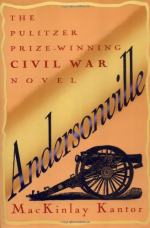“Brisoners, I pring you pack two of dem tam Yankees wat got away yesterday, unt I run de oder raskal into a mill-pont and trowntet him.”
What was our astonishment, about three weeks later, to see Tom, fat and healthy, and dressed in a full suit of butternut, come stalking into the pen. He had nearly reached the mountains, when a pack of hounds, patrolling for deserters or negros, took his trail, where he had crossed the road from one field to another, and speedily ran him down. He had been put in a little country jail, and well fed till an opportunity occurred to send him back. This patrolling for negros and deserters was another of the great obstacles to a successful passage through the country. The rebels had put, every able-bodied white man in the ranks, and were bending every energy to keep him there. The whole country was carefully policed by Provost Marshals to bring out those who were shirking military duty, or had deserted their colors, and to check any movement by the negros. One could not go anywhere without a pass, as every road was continually watched by men and hounds. It was the policy of our men, when escaping, to avoid roads as much as possible by traveling through the woods and fields.
From what I saw of the hounds, and what I could learn from others, I believe that each pack was made up of two bloodhounds and from twenty-five to fifty other dogs. The bloodhounds were debased descendants of the strong and fierce hounds imported from Cuba—many of them by the United States Government—for hunting Indians, during the Seminole war. The other dogs were the mongrels that are found in such plentifulness about every Southern house—increasing, as a rule, in numbers as the inhabitant of the house is lower down and poorer. They are like wolves, sneaking and cowardly when alone, fierce and bold when in packs. Each pack was managed by a well-armed man, who rode a mule; and carried, slung over his shoulders by a cord, a cow horn, scraped very thin, with which he controlled the band by signals.




